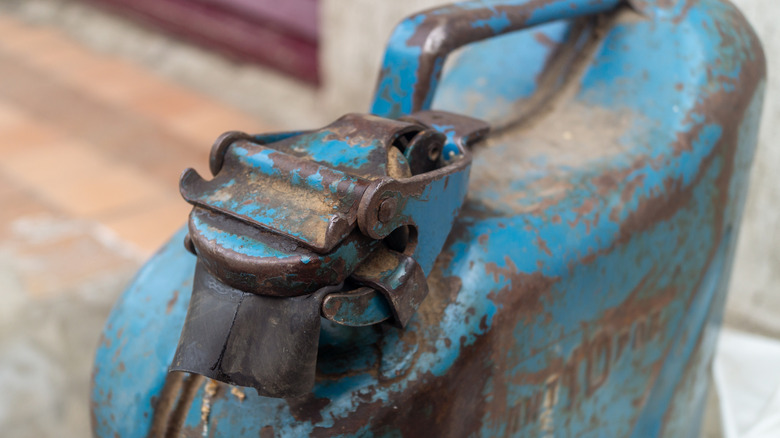What Happens If You Put Old Gas In Your Car?
You know how, in some post-apocalyptic movies, you still see people driving around in cars despite the lack of gasoline infrastructure? That wouldn't actually work in real life, and it's not because there wouldn't be any more gas. The problem is that gas doesn't last forever. The precise shelf life of gasoline varies based on a few factors, but generally, any unburned gas — even when properly stored — would eventually go stale after a few years.
You might be thinking, "Well, gas is gas, isn't it? As long as you can still pour it into a fuel tank, it should still be fine to use!" Sadly, the laws of thermodynamics aren't quite that accommodating. Attempting to use old, stale gas in your car might still make it move a bit, but it'll also inflict lasting damage and corrosion on your car's internal components. Whether you're living in a desert wasteland or just found an old gas can in a dusty corner of your garage, old gas is best not used in a car.
Old gas can damage and gum up your engine
Gasoline, in its fresh state, has a very particular chemical composition that makes it ideal for efficient combustion. You get exactly as much performance out of the gas that you put in your tank. However, even processed gas is still technically a natural substance, and like all natural things, it gradually starts to break down with time. When gas starts to go stale, it starts evaporating and oxidizing, contaminating itself with solid particulates and gummy residues.
If you tried to use stale gas in your car, you might be able to drag a bit of power for the combustion process out of whatever vestiges still remain. You won't get far, though, because all those particulates will cause the fuel to burn incorrectly. This will lead to physical damage on your engine and its components.
Not only that, but that gummy residue we mentioned will also begin to coat the internals of the fuel line. This can lead to solid blockages that could prevent any fuel from getting into the engine intake. Depending on the precise kind of fuel you're using, there may be additional detrimental effects — for instance, if you're using fuel with a higher degree of ethanol in its blend, you might end up with water in the fuel line, which can lead to internal corrosion.
Gas has a shelf life ranging from a month to several years
How long fuel will last before it goes stale depends on a few factors, such as the fuel's precise chemical makeup and how you stored it. In the best-case scenario — specifically gas with added fuel stabilizer that's been stored in a sealed metal container — you might get as many as three years of shelf stability. Of course, this is all assuming you made sure to add stabilizer and store the fuel properly.
If you just pour some regular gas into a fuel can and leave it in your garage, you might get around three to six months of shelf life. That decreases further the more ethanol is in the fuel, since ethanol is corn-derived and degrades a bit faster. The absolute worst thing you can do is just leave gas in your car's fuel tank. In that case, the fuel will start to go bad after just a month.
The best practice for fuel storage is to write the date you stored it somewhere on the can. If you didn't do that, though, you can make an educated guess based on the fuel's appearance and smell. Stale gas takes on a dark, murky color and an unpleasant, sour smell. Basically, treat your gas with the same kind of skepticism that you would an old carton of milk. Otherwise, you could do serious damage to your car, requiring some expensive repairs depending on the severity of the damage.


